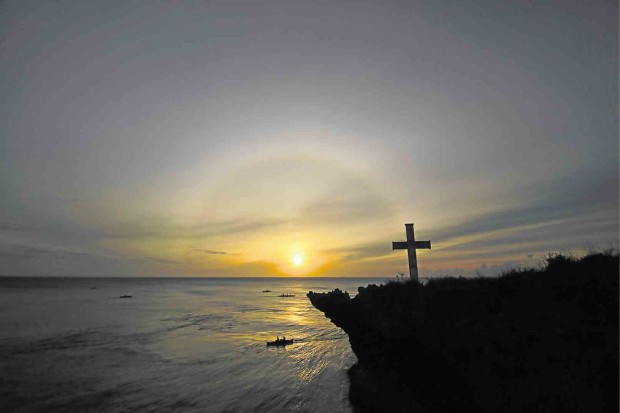
THE FIRST rays of the sun make their majestic presence felt in Pusan Point in Davao Oriental province. EDEN JHAN LICAYAN/CONTRIBUTOR
THE FIRST rays of the rising sun strike the Philippines on a 40-foot high rock promontory known as Pusan Point, which faces the Pacific Ocean, in Caraga, Davao Oriental province.
Tourism officials are now calling the place the newest gem of the picturesque eastern province of Mindanao following the recent opening of the Pusan Point Discovery Center and Eco-Park in Barangay Santiago.
Gov. Corazon Malanyaon said the vantage point would be the latest addition in ecotourism destinations to be opened by Davao Oriental “to its people and to the rest of the world.”
Pusan last gained prominence and attracted local and foreign tourists and journalists on Jan. 1, 2000, as the Philippines’ welcome mat for the new millennium.
Its development was the provincial government’s effort to maximize the point’s natural ecotourism draw, so that it would have more to offer than just the glimpse of the Philippines’ first day, Malanyaon said.
New landmark
The point hosts two concrete lighthouses, one of which was built in the early 1900s. With the establishment of the Pusan Point Discovery Center and Eco-Park, a new landmark, according to the governor, “(would) complement the site’s substance.”
A concrete Jubilee Cross planted on the rough edges of the point where the Pacific surf pounds violently, especially during the monsoon season, forms part of the park’s attractions.
Meditation kiosks are also strategically built on its grounds, as well as an amphitheater that can seat 100 people.
Other facilities include a 200-square-meter swimming pool, a sundial and a two-story building that houses the Science Discovery Center featuring a planetarium and other science-themed interactive sections.
Duterte factor
Roberto Alabado III, regional tourism chief, said Davao Oriental’s newest ecotourism attraction would further lift the local tourism industry.
He said his office was banking on the popularity and buzz generated by the Davao region following the election to the presidency of Davao City Mayor Rodrigo Duterte, in marketing Davao Oriental to local and foreign tourists.
“This is our time, especially now that we have a President who comes from Davao. The word Davao now exudes beauty. It exudes discipline. It exudes public service. Now, the word Davao is known internationally. That is a very, very welcome marketing tool,” he said.
‘World-class’
Alabado pointed out that Southern Mindanao’s largest province had virtually all that could attract visitors—ecotourism sites, museums, historical places and rich Mandaya culture and traditions.
Caraga, 82 kilometers from the capital of Mati City, is also home to pristine beaches and waterfalls, as well as one of Mindanao’s oldest churches, the San Salvador del Mundo parish church at the town center, which was built by the Spaniards during the late 19th century.
Alabado called the tourism destinations “world-class.”
“You’ve got everything here. From dolphins, sea cows, sea turtles, whales, beaches… and so many more. When everything is here, that’s tourism. That makes your province a tourism destination, an ecotourism destination,” the official said.
‘Wow factor’
Alabado lauded the efforts of the provincial government in embarking on big tourism infrastructures that rivaled or even surpassed those undertaken by the private sector.
Malanyaon said Pusan Point would further be improved by offering more amenities to tourists, such as camping tents and other facilities for overnight stay. She expressed hope that it would open more livelihood opportunities to residents.
Alabado suggested that those living around major tourism sites such as Pusan Point be tapped to provide homestay accommodation to visitors.
The scheme is being encouraged following the opening of the Unesco-recognized Mt. Hamiguitan World Heritage Park in San Isidro municipality to the southeast on May 4. President Aquino led the inauguration of the ecotourism facility.
“The province has never failed to give tourists the wow factor. … we (have) great things to market for tourism,” Alabado said.